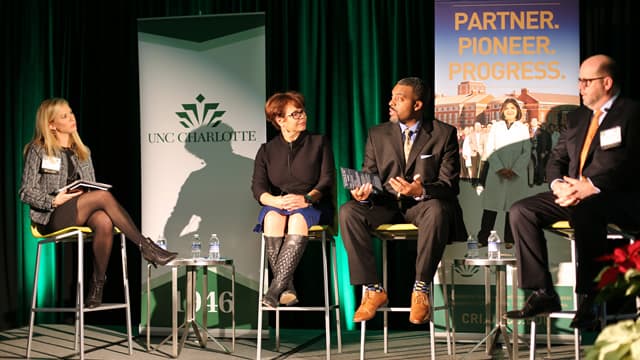
UNC Charlotte brought together almost 200 people to share their visions for the future of University City, at the PORTAL Building on Thursday, Dec. 8. City planners, consultants, University administrators, politicians and civic boosters gathered for a series of briefings and a panel discussion sponsored by the Charlotte Research Institute and University City Partners.
The general theme of UNC Charlotte as an anchor that sets the standard for “walkable urbanity” resonated through the presentations.
“This is an exciting time to be part of the development and growth of University City, anchored by UNC Charlotte,” said Alyson Craig, co-director of the Childress Klein Center for Real Estate in the Belk College of Business. “UNC Charlotte will continue to bring people together and help drive conversations with the community, developers and public officials to decide what’s the best plan for University City and how do we grow from here.”
“We’re working closely with planners, designers and engineers to plan trail-oriented development for University City,” said John Cock, vice president with Alta Planning + Design in Davidson. He described a vision for the Toby Creek Greenway, which crosses the UNC Charlotte campus, to extend further from the intersection of University City Boulevard and E. W.T. Harris Boulevard, southward as part of the Cross Charlotte Trail. He described potential upgrades to make the extended trail safe and environmentally pleasing, including public art. Cock said he’s already conferred with 170 city planners, designers, College of Arts + Architecture urban design students, Facilities Management staff and others.
Glenn Walters, of the Asheville-based Design Workshop firm, showed ideas for enhancing walkability in the area around the University Place mixed use development and lake near North Tryon Street and J. W. Clay Boulevard transit station. He is engaged in reimagining that area as more of an urban neighborhood comprising multiple “nodes” of retail and housing, which might include a University-focused mixed use district. Walters said the area will become a “civic spine” that could include a relocated county library, a possible charter school and other features.
Stuart Parks, of the Arden Group in Winston-Salem, described how long-term planning for University City will encompass parking, housing, retail and other businesses to present a dynamic transit-oriented community. “The future of University City will be urban in scale and design. Retrofitting the current automobile-oriented environment into an area of walkable urbanity is no longer an ornament in attracting investment,” he said. “It is now required in order to drive economic development.”
Charlotte May Pro Tem Vi Lyles spoke to the urbanity issue when she recalled her work more than 25 years ago in shaping the original University Research Park and University Place developments. Lyles said that then, visionaries pictured a suburban future for this neighborhood. But, she said, young people and retirement-age citizens now have different expectations and tastes, leaning more toward denser, walkable, bike-friendly neighborhoods. Lyles, a longtime civic and political leader, also serves as chair of the Charlotte City Council’s Transportation and Planning Committee.
“Anchors such as UNC Charlotte develop talent – preparing people for the workforce – they provide job opportunity, and they provide connectivity between housing and work,” Lyles said. “What makes this planning come alive is people – their commitment to the vision and mission of it. People will work together around these investments. UNC Charlotte has absolutely been a key partner; the University is making a tremendous difference in helping shape University City.”